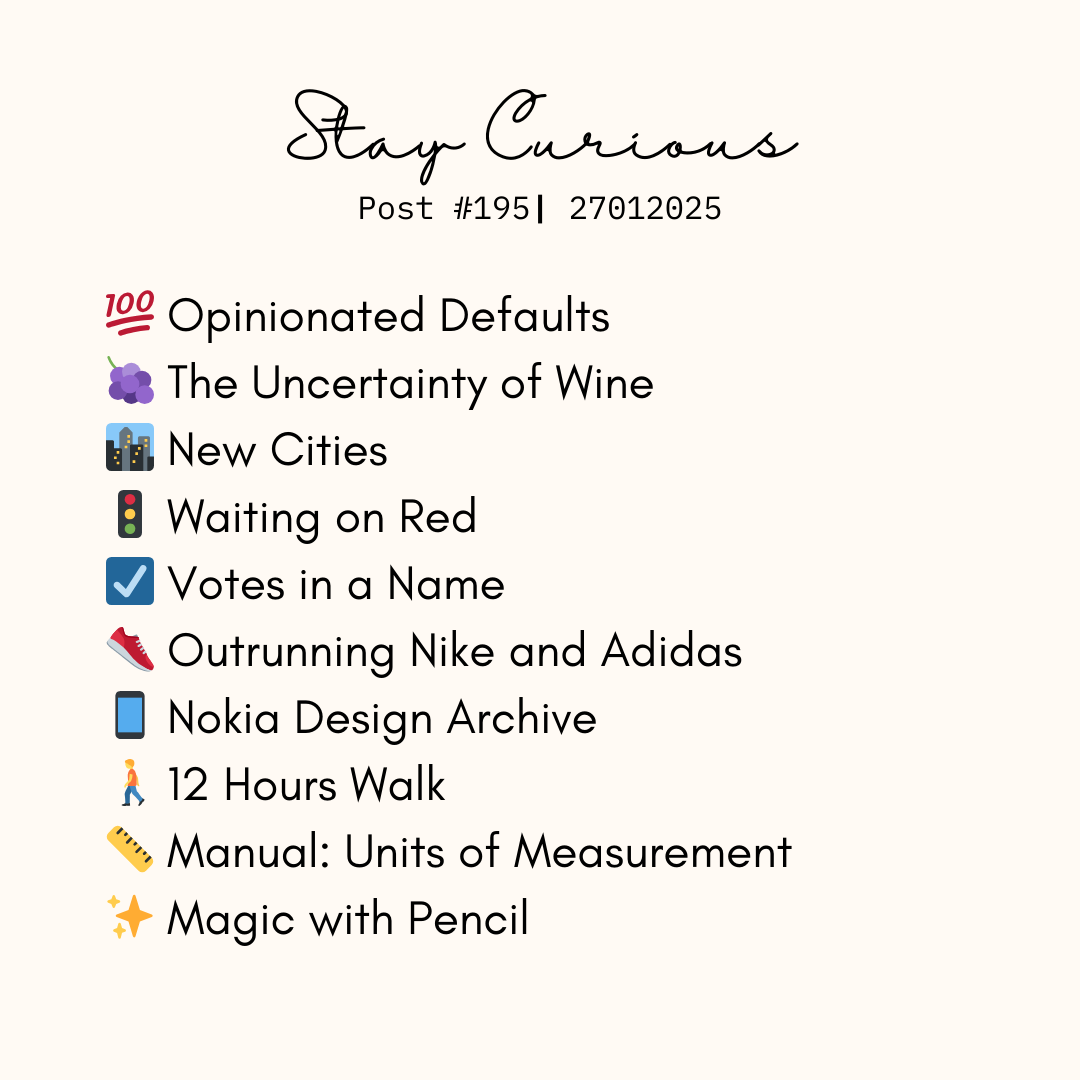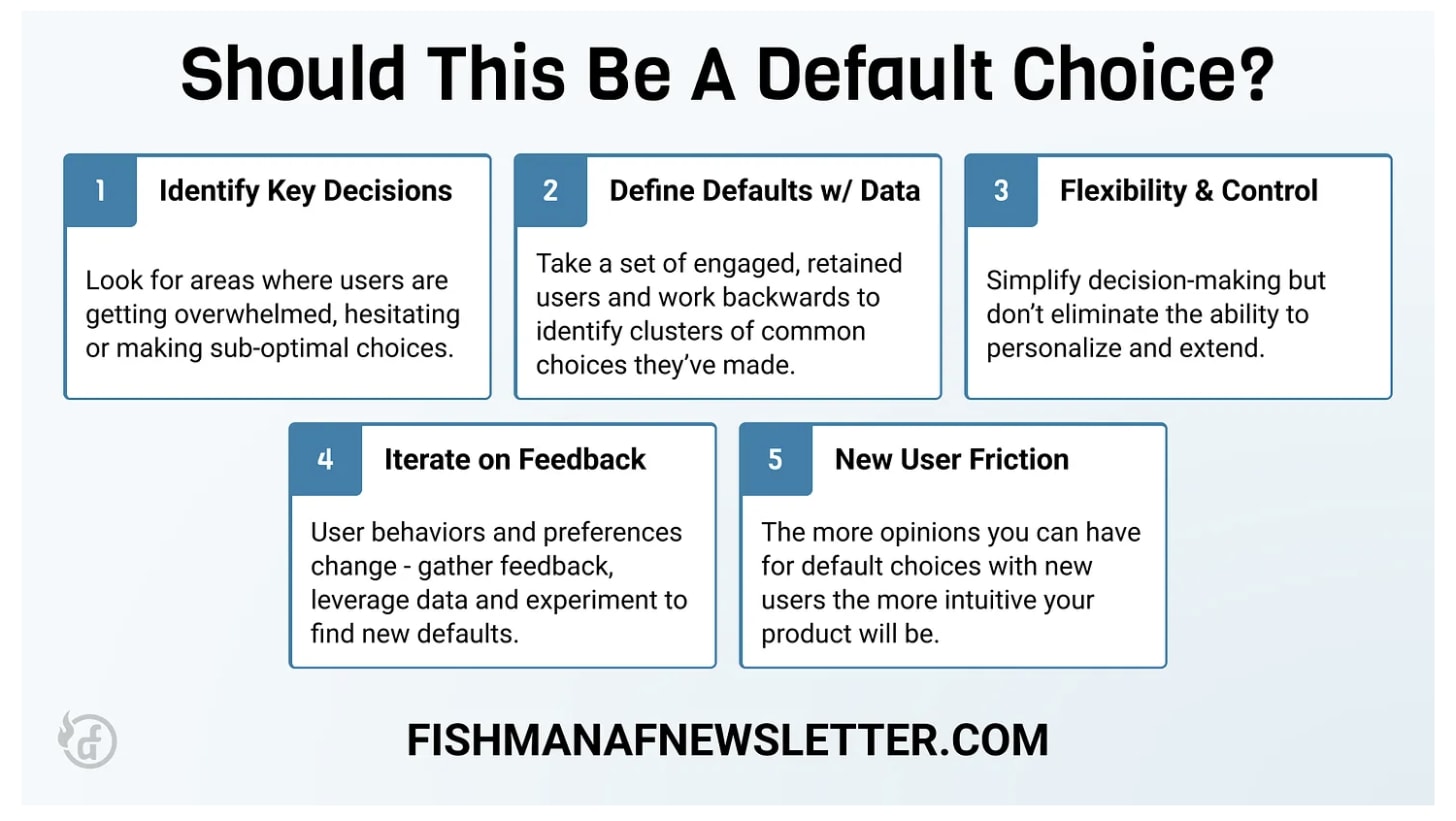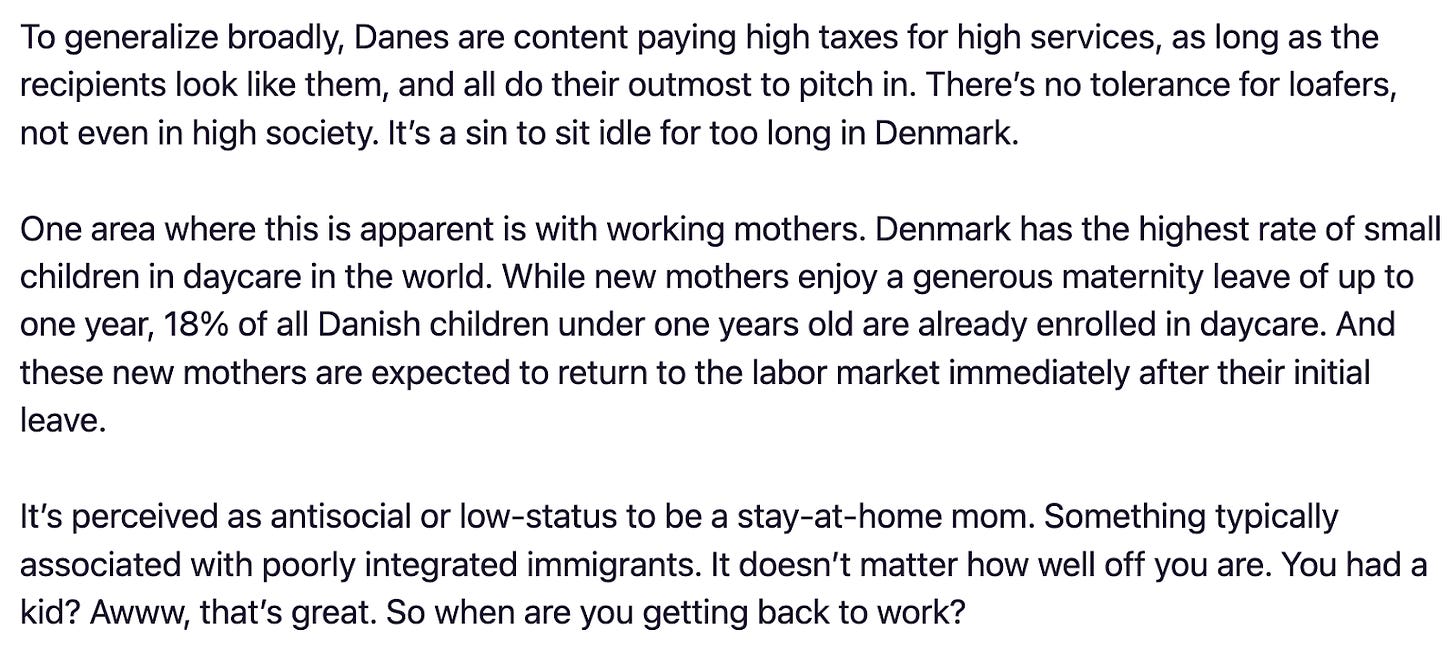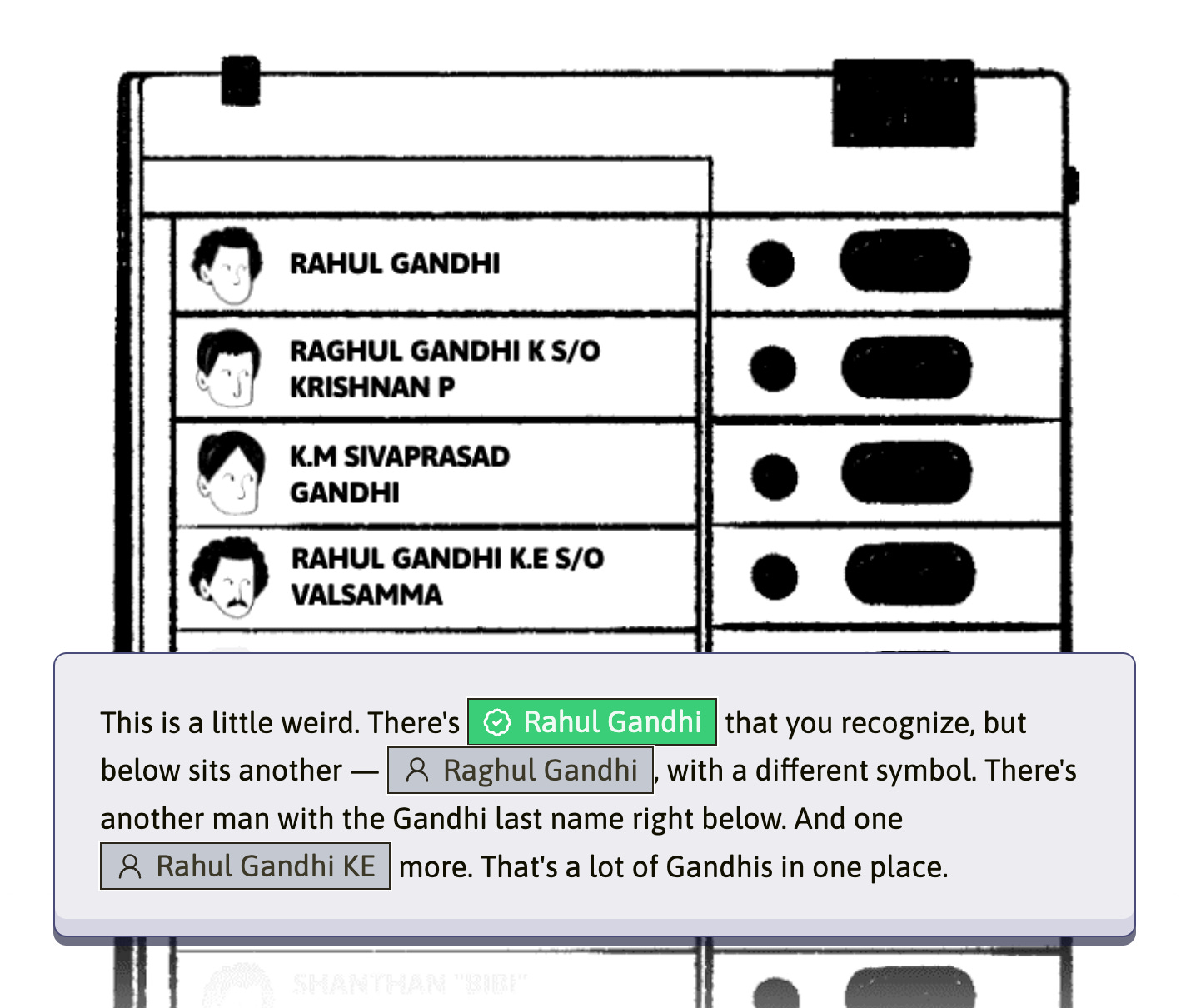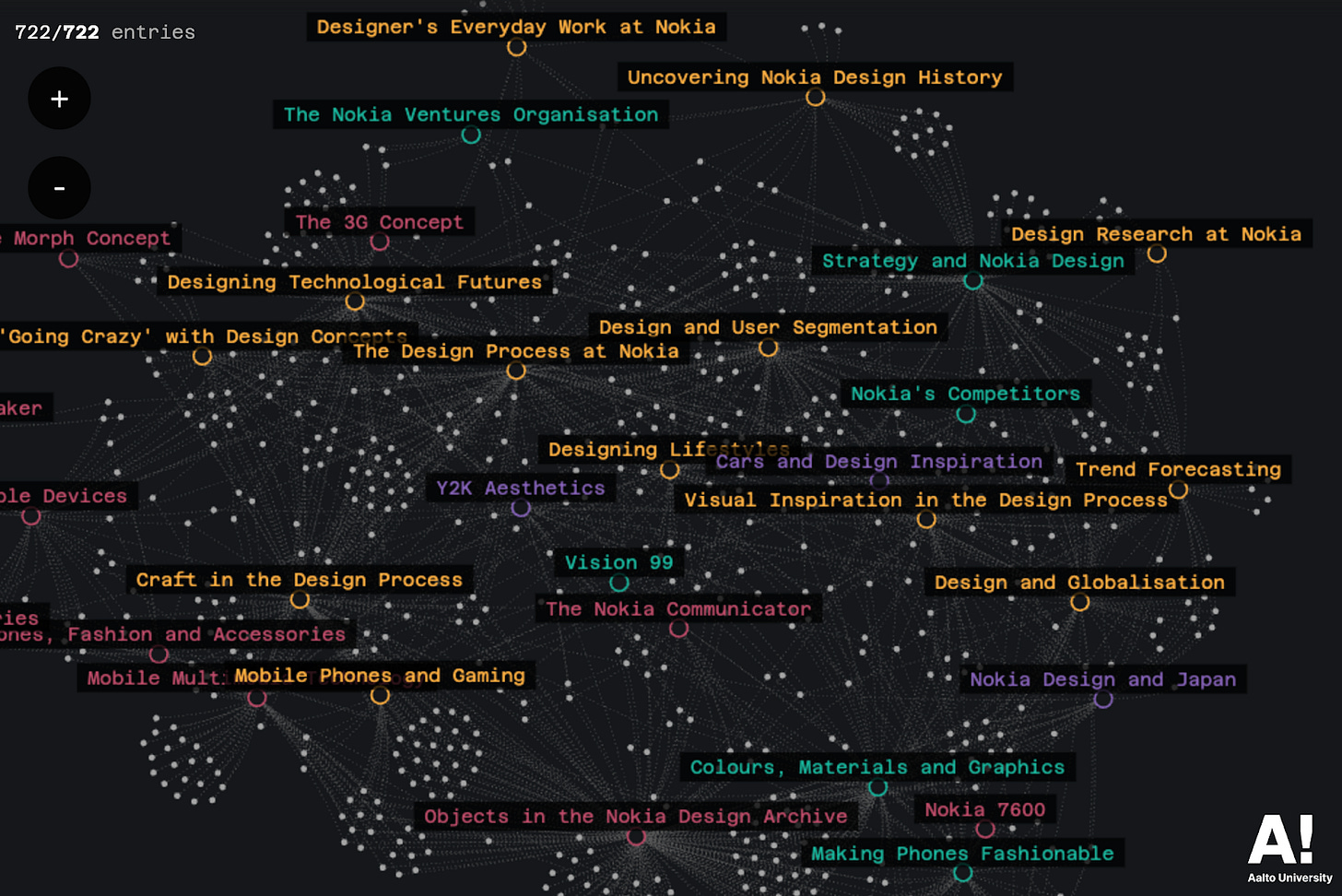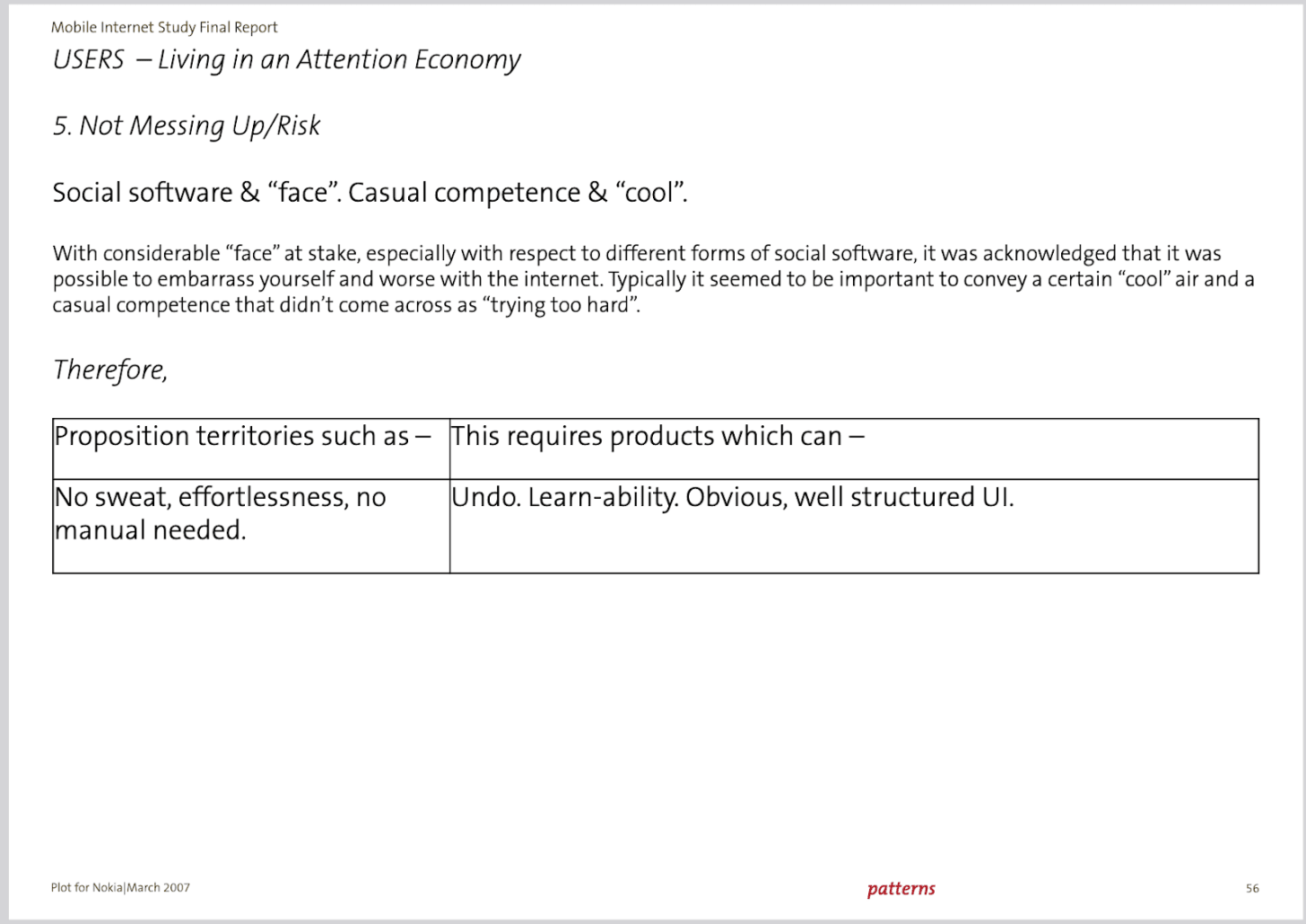📚 Opinionated defaults, Uncertainty of wine, New cities, Waiting on red, Votes in a name, Outrunning Nike and Adidas
Nokia Design Archive, 12 Hours Walk, Units of Measurement and Magic of Pencil
Hello, this is post #195!
A warm welcome to everyone who joined us last week, thanks to Mona Gandhi’s wonderful shoutout! Your curiosity is truly commendable.
Last week, James Clear shared a brief yet powerful thought on “what it takes to be consistent”.
In theory, consistency is about being disciplined, determined, and unwavering.
In practice, consistency is about being adaptable. Don't have much time? Scale it down. Don't have much energy? Do the easy version. Find different ways to show up depending on the circumstances. Let your habits change shape to meet the demands of the day.
Adaptability is the way of consistency.
For the past 195 Mondays, I’ve consistently published this newsletter—a streak I’m deeply proud of. But let me tell you, it hasn’t always been easy. Balancing intense work phases or major personal commitments has often been a challenge. So far, I’ve leaned heavily on discipline to keep things going, rarely opting for flexibility.
Moving forward, I plan to embrace a more adaptive approach while staying committed to curating the best of what I learn and sharing it with you. Everything else will evolve naturally with the flow of life.
With that said, let’s dive into today’s post! Here’s what’s on the menu:
Let’s get started…
💯 Opinionated Defaults
A recent post by Demand Curve dives into the concept of “Opinionated defaults,” expanding on Adam Fishman’s “Leveraging opinionated defaults to power growth”. Both pieces are packed with insightful examples to help you understand this approach and how it can be used to boost growth while enhancing user experience.
Let’s get the jargon out of our way. As Neal puts it in his post:
Opinionated defaults are pre-selected choices within your product that nudge users toward desired actions—or that simply make the experience that much easier or more delightful.
Adam offers it in a slightly broader way:
Another way to think about opinionated defaults is like the executive summary of a document. The author is telling you what the most important information is based on their knowledge of the document. You can get most of the benefit by reading the summary (or following the default suggestions) but a power user may want to dig into the details (customize beyond the defaults).
You get the gist. Whether it’s pre-setting trip origins in Uber or default donation amounts in payment flows, these small nudges simplify decision-making for users.
Two important lessons that I picked up from this post:
Make your opinionated defaults loosely held. Make it easy for users to adjust or override these presets. While defaults are meant to guide the ‘new,’ ‘average,’ or even ‘habitual’ user, they shouldn’t come at the expense of flexibility.
Fishman’s framework for opinionated defaults.
🍇 The Uncertainty of Wine
In “Stacking the deck”,
introduces us to ‘low-intervention wines’. I am not into wines or winemaking, so the topic intrigued me specially because it is coming from someone who focuses primarily on ‘uncertainty in daily and organizational life.’Here’s how Vaughn sets the context (highlight mine):
You may have heard of low-intervention wine as “natural wine.” … I prefer calling it “low-intervention” because all winemaking involves intentionally transforming grape juice into something that generally does not exist in nature—but some wines are much more unnatural than others.
From the winemaking perspective, natural wine implies both less intervention and a different kind of intervention. For the here and now, what’s important is that low-intervention wine requires the winemaker to voluntarily give up control both practically and philosophically.
He offers a quick overview of the winemaking process, quite a revelation for me. However, it’s bits like these that make this one a fun & insightful reading:
One question that came up was how often he tasted the fermenting juice to make sure it was going in the right direction. His reply: “When you are just starting to make wine, you’re tasting and tasting and tasting every day and every week and you do something because the wine tastes this way or that way. It makes you crazy. But the wine is changing all the time, it is becoming what it wants to be. There is no point to taste so often.” Control in the high-intervention sense requires surveillance; when you relinquish that kind of control, you require less surveillance.
Control in the low-intervention sense is applied in a different place: the vineyard. Every winemaker we visited emphasized the importance of the raw material— the grapes from which the wine is made. In low-intervention wine, the vineyard is managed as a system and the goal is to bring the system into a sense of balance. This requires abandoning many conventional vineyard management principles.
On stacking the deck vs deterministic control
The most important insight from looking at low-intervention winemaking is that it shows the difference between two different ideas of control. The high-intervention winemaker thinks of control in a deterministic sense, taking a series of actions each of which dominates the outcome in a specific and predictable way.
The low-intervention winemaker influences the outcome without assuming deterministic control or having a specific and predictable objective. Actions taken are not individually dominating; instead, as a whole they are intended to move the entire system in an amorphous but generally desirable direction.
(via Commoncog)
🏙️ New Cities
If you’re into geopolitics and how it shapes culture and economies,
’s “Uncharted Territories” is a great source. His posts are detailed, packed with historical insights, intuitive charts, and eye-catching visuals that make complex topics engaging.Recently, he explored U.S. cities in a fascinating series. Starting with the top 50 cities, he shared insights about their locations, key roles, and what makes them unique. He then delved into how to identify ideal sites for new cities from first principles, eventually proposing 10 potential new city locations in the U.S.
Places like Guantanamo City, Starbase, which you might have heard of, were examined in detail, offering deeper context about their geography, resources, and potential significance in the future.
Fair warning: Some of these posts could be behind a paywall. You will still find some great free posts to read & experience his work on similar themes.
🚦Waiting on Red
DHH’s writing has been my window of opportunity to know more about Danish culture. Here’s a snapshot from a recent post: Waiting on red
The last two paragraphs highlight a crucial insight: rules without enforcement often fail to achieve their purpose. Enforcement, however, comes with costs—both direct and indirect. Disciplined societies learn to balance these aspects, ensuring rules are respected while minimizing friction.
Earlier, he explored how their welfare state approach, particularly in education and healthcare, sets them apart globally.
These are bold opinions, and the 'fairy tale life' comes with its own costs. DHH is a firm believer in this approach, as are many Danes. For everyone else, it’s essential to understand the full context and consider how to adapt or adopt aspects of it to enhance life in your own way.
☑️ Votes in a name
Aman Bhargava & Reechik Banerjee make a visually stunning piece exploring the issue of “Namesakes in Indian elections”.
Take a quick look at their interpretation of how the voting machine could have looked to a voter in the last election in Wayanad. You get the issue?
Their visual essay masterfully presents their methodology and key findings. I cannot do justice in representing their work here, you’ve to check it out on their interactive site. I loved it for its creative storytelling—projects like this prove that great storytelling opportunities exist in everything.
I discovered this through The Pudding’s recommendation list. They’re my go-to source for inspiring and fun data stories. If you haven’t subscribed to them yet, you definitely should!
👟 Outrunning Nike and Adidas
If you're into running or a sneakerhead, you might already know 'On'. I’m not, but I’ve started seeing them around (I do hang out with some cool folks, you know). The name always confused me—I thought it was 'On Cloud' and used that in some conversations. Their logo is beautiful but also a bit puzzling. What does it even read? And the price? Definitely not something I’d buy on a regular day.
But this recent Bloomberg post cleared up a lot of my misconceptions and helped me understand why this Swiss sneaker brand is outrunning Nike and Adidas.
Some interesting bits, strting with how Federer came onboard:
Then On experienced a sort of only-in-Switzerland windfall. Another early investor was a fund backed by billionaire investment banker Jorge Paulo Lemann, who has a home on Lake Zurich. At the time, Lemann was letting tennis star Roger Federer use his grass court to get in shape for Wimbledon. In the summer of 2018, Federer ended his contract with Nike and before long agreed to meet for dinner in Zurich with the On partners, who, incidentally, had noticed photos on social media of Federer’s wife, Mirka, wearing Ons. When Federer visited On’s campus—known as On Labs, which along with a sleek office includes a skunkworks filled with sneaker components and cobbling machines—the partners put him on a treadmill in a pair of Cloudsurfers. He had told them he could stay for only 20 minutes, but didn’t end up leaving for several hours. Soon Federer was on board to buy a stake in the company and help champion its entry into tennis, replete with a new line called the Roger.
On’s fear of becoming a lifestyle brand
This was exacerbating a conundrum for the company, which wanted to be taken seriously as an athletic player but was being embraced for its fashionable comfort. On Clouds had become ubiquitous in Germany, Austria and Switzerland, but as the go-to shoe for doctors, nurses, restaurant workers and seniors. A similar situation played out in Japan.
Fearing that On could lose its sports cred, in 2023 the partners began removing its products from some 200 locations across those smaller European markets swooning over the brand’s orthopedic benefits. Sure, it would sacrifice some sales, but by then most of On’s growth was happening in the US, and it needed to stay in control of the brand’s image.
(via The Profile)
📱 Nokia Design Archive
In “From brick to banana: The Nokia Design Archive traces two decades of iconic devices,” Marigold Warner reports…
Nokia didn’t just make phones, it shaped identity. Before iPhones or Samsungs were the de facto choice, mobile phones were an extension of who you were. Nokia made these devices desirable – fashionable, even. It pioneered the idea of tech as self-expression, at a time when it wasn’t about likes, comments or shares – it was about who you were when you pulled your phone out of your pocket.
Now, for the first time, a massive archive of Nokia’s design history from the mid-90s to 2017 will be freely accessible. The Nokia Design Archive launches today, 15 January, presenting more than 700 images, sketches, never-before-seen prototypes, and interviews with designers.
My first phone wasn’t a Nokia (unfortunately), but every phone I owned after that, until I left Nokia, was a Nokia. In 2010, I was fresh out of college and learned the ropes of sales and marketing there. I got a taste of Nokia's magic—its design and passion—while also facing market challenges and customer demands. I used to love going through our design and inspiration decks and even saved some wallpapers for personal inspiration.
This archive reveals so much more than what I experienced—there's some real magic and genius here. Here’s a quick look at the index of what it covers.
A sample slide I stumbled upon:
Take a look, you might be surprised by what you find. At the very least, some nostalgia will definitely hit you.
✨ Everything else
- did a 12 Hour Walk in Abu Dhabi — a concept that sounds both fascinating and intensely challenging. Honestly, I’m not sure if I could manage something like that myself! His reflections make for a great read, though. It’s the little moments of joy he captures that truly stand out.
Units of Measurement. How to type the various units of measurement correctly? Tiny details that matter to some! (via Sidebar)
Finally, some eye candies courtesy Colossal - a giant sharpener creates playful pendant lights that mimic colored pencil shavings (I so want to have them in my living room) and The secret life of the pencil: an abstract portrait series of today's creatives as seen through their pencils (so cool to notice such simple things, isn’t it?).
ICYMI…
“Thoughts on experience economy”, “Software folklore” and
’s Zakir are my favorites from last week’s post. I’m still not over Laura’s “Handcrafted stamp collection”. Here’s the link to the post in case you want to check it out:That's all for this week, folks!
I hope I've earned the privilege of your time.
If you liked this post, please hit the ❤️ below and leave a comment to tell me more. Forward it to a friend who will find it useful, there is no better way to make this world more curious!




